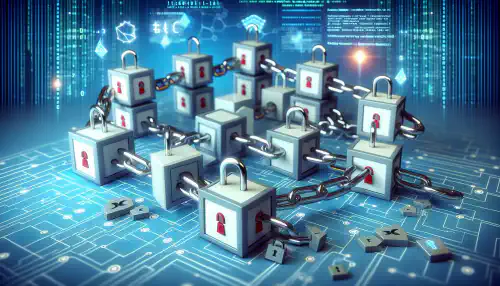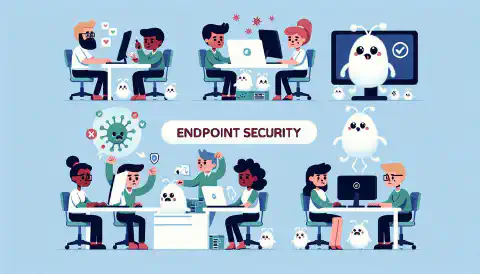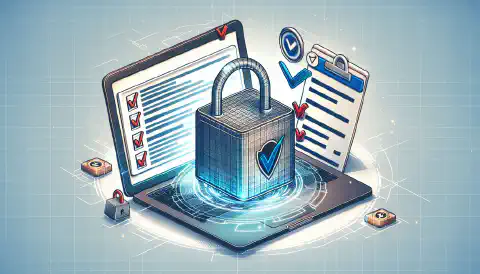Blockchain Security Unveiled: Beyond Cryptocurrency, Safeguarding the Digital Frontier

Table of Contents
Demystifying Blockchain Security: More Than Just Cryptocurrency
Blockchain technology has revolutionized the way we think about security in the digital world. While often associated with cryptocurrencies, blockchain offers much more than just financial transactions. In this article, we will explore the fundamentals of blockchain security, discuss methods to secure blockchain networks from external threats, address internal vulnerabilities in blockchain systems, examine emerging technologies for enhanced security, and highlight the role of security audits in blockchain development.
Key Takeaways
- Decentralization is a key aspect of blockchain security, as it ensures that no single entity has control over the network.
- Consensus mechanisms play a crucial role in maintaining trust and security in blockchain networks.
- Immutability is a fundamental feature of blockchain that protects the integrity of data stored on the network.
- Cryptography is used to safeguard transactions and identities in blockchain systems.
- Network security measures, such as firewalls and encryption, are essential to prevent unauthorized access to blockchain networks.
Understanding the Fundamentals of Blockchain Security
Decentralization: The Key to Blockchain Security
Blockchain security relies heavily on the principle of decentralization, which is a fundamental aspect of the technology. Decentralization refers to the distribution of authority and control across a network of nodes, rather than relying on a central authority. This decentralized nature of blockchain provides several key benefits for security:
- Resilience to attacks: By distributing the network across multiple nodes, blockchain becomes more resilient to attacks as there is no single point of failure. Even if some nodes are compromised, the network can continue to function.
- Tamper-proof transactions: Decentralization ensures that transactions recorded on the blockchain are tamper-proof. Each transaction is verified and validated by multiple nodes, making it extremely difficult for any malicious actor to alter the transaction history.
- Trustless consensus: Through decentralization, blockchain achieves trustless consensus, meaning that participants can trust the integrity of the system without relying on a central authority.
In summary, decentralization is a crucial component of blockchain security, providing resilience, tamper-proof transactions, and trustless consensus.
Immutability: Protecting Data Integrity on the Blockchain
As a cybersecurity expert, it is crucial to understand the concept of immutability in the context of blockchain security. Immutability refers to the inability to change or alter data once it has been recorded on the blockchain. This feature is achieved through the use of cryptographic hash functions and the consensus mechanism of the blockchain network.
Immutability ensures the integrity of data on the blockchain by preventing unauthorized modifications or tampering. Any attempt to alter a transaction or record would require the consensus of the majority of network participants, making it extremely difficult and computationally expensive to tamper with the data.
To further illustrate the importance of immutability, consider the following table:
| Data Type | Immutability | Use Case |
|---|---|---|
| Financial transactions | High | Ensuring transparent and tamper-proof financial records |
| Supply chain information | Medium | Verifying the authenticity and traceability of products |
| Identity records | Low | Protecting personal information and preventing identity theft |
This table demonstrates how different data types require varying levels of immutability based on their specific use cases. Financial transactions, for example, require a high level of immutability to ensure transparent and tamper-proof financial records.
In addition to the table, it is important to note that immutability also plays a crucial role in preventing fraud and maintaining trust in blockchain networks. By ensuring that data cannot be altered or manipulated, blockchain technology provides a secure and reliable platform for various applications beyond just cryptocurrency transactions.
Tip: When designing blockchain systems, it is essential to carefully consider the level of immutability required for the specific use case and implement appropriate cryptographic measures to protect the integrity of the data.
Securing Blockchain Networks from External Threats

Cryptography: Safeguarding Transactions and Identities
Cryptography plays a crucial role in ensuring the security of transactions and identities on the blockchain. By employing cryptographic techniques, sensitive information is protected from unauthorized access and tampering. Encryption is used to secure the content of transactions, making it unreadable to anyone without the proper decryption key. Digital signatures are utilized to verify the authenticity and integrity of transactions, ensuring that they have not been altered in transit. Additionally, hash functions are employed to create unique identifiers for transactions, making it virtually impossible to modify the data without detection.
Network Security: Preventing Unauthorized Access
Network security is a critical aspect of blockchain systems, as it ensures that only authorized entities can access and participate in the network. By implementing robust security measures, blockchain networks can prevent unauthorized access and protect the integrity of the data stored on the blockchain. One of the key features of blockchain technology is its decentralized nature, which means that the blockchain records transactions across multiple computers. This distributed architecture makes it difficult for malicious actors to tamper with the data or gain control over the network. Additionally, cryptographic techniques such as public-key encryption and digital signatures are used to secure transactions and verify the identity of participants. These cryptographic mechanisms provide a strong layer of protection against unauthorized access and ensure the authenticity and integrity of the data on the blockchain.
Smart Contract Auditing: Mitigating Vulnerabilities
Smart contract auditing plays a crucial role in ensuring the security and reliability of blockchain systems. By thoroughly reviewing and analyzing the code of smart contracts, cybersecurity experts can identify and mitigate potential vulnerabilities that could be exploited by malicious actors. Auditing smart contracts is especially important in the context of decentralized applications (dApps) and cryptocurrencies, where the execution of code is automated and irreversible. The goal of smart contract auditing is to minimize the risk of security breaches and protect the assets and transactions of users.
Addressing Internal Vulnerabilities in Blockchain Systems

Permissioned Blockchains: Controlling Access and Permissions
Permissioned blockchains are a type of blockchain network that restricts access and permissions to a select group of participants. Unlike public blockchains, which are open to anyone, permissioned blockchains require users to be granted permission before they can participate in the network. This controlled access ensures that only trusted entities can join the blockchain, enhancing security and reducing the risk of unauthorized activities.
Governance Models: Ensuring Accountability and Security
Governance models play a crucial role in ensuring accountability and security in blockchain systems. These models define the rules and processes for decision-making, resource allocation, and dispute resolution within a blockchain network. By establishing clear governance structures, blockchain networks can mitigate the risk of malicious activities and maintain the integrity of the system.
One effective governance model is the participatory model, where decision-making power is distributed among network participants. This model promotes inclusivity and decentralization, allowing stakeholders to have a say in the development and evolution of the blockchain network. By involving a diverse range of participants, the network can benefit from a wider range of perspectives and expertise, reducing the likelihood of biased decision-making.
Another governance model is the hierarchical model, where decision-making power is concentrated in a central authority or a small group of individuals. This model can provide efficiency and quick decision-making, but it also introduces the risk of centralization and potential abuse of power. To mitigate these risks, checks and balances should be implemented to ensure transparency, accountability, and the protection of user rights.
In addition to these models, a hybrid model can also be employed, combining elements of both participatory and hierarchical models. This allows for a balance between decentralization and efficiency, leveraging the strengths of each model while mitigating their respective weaknesses.
To ensure the effectiveness of governance models, it is essential to establish clear guidelines and protocols for decision-making, resource allocation, and conflict resolution. Regular audits and reviews should be conducted to assess the compliance of the governance model with the network’s objectives and to identify any potential vulnerabilities or areas for improvement. By continuously evaluating and refining governance models, blockchain networks can enhance their accountability and security.
Privacy Enhancements: Protecting Sensitive Information
Privacy enhancements play a crucial role in ensuring the security of sensitive information on the blockchain. By implementing various techniques and protocols, blockchain systems can protect the confidentiality and integrity of data stored on the distributed ledger. These privacy enhancements provide individuals and organizations with the assurance that their sensitive information remains secure and inaccessible to unauthorized parties.
Emerging Technologies for Enhanced Blockchain Security

Multi-Factor Authentication: Strengthening User Verification
Multi-Factor Authentication (MFA) is a crucial security measure that enhances user verification in blockchain systems. By requiring users to provide multiple forms of identification, MFA significantly reduces the risk of unauthorized access and identity theft. This subheading explores the various methods and technologies used in MFA to strengthen user verification.
- MFA combines two or more authentication factors, such as something the user knows (e.g., a password), something the user has (e.g., a physical token), and something the user is (e.g., biometric data).
- One common implementation of MFA is the use of one-time passwords (OTP), which are generated and sent to the user’s registered device for each login attempt.
- Biometric authentication, such as fingerprint or facial recognition, adds an extra layer of security by verifying the user’s unique physical characteristics.
Benefits of Multi-Factor Authentication:
| Benefits |
|---|
| Enhanced security by requiring multiple forms of identification |
| Reduced risk of unauthorized access and identity theft |
| Protection against brute-force attacks and password guessing |
| Increased user confidence and trust in the system |
Tip: It is important to choose MFA methods that are convenient for users while maintaining a high level of security.
Implementing MFA in blockchain systems is crucial to protect sensitive data and prevent unauthorized access. By combining multiple authentication factors, MFA strengthens user verification and significantly reduces the risk of security breaches.
Zero-Knowledge Proofs: Balancing Privacy and Transparency
Zero-Knowledge Proofs (ZKPs) are a powerful cryptographic tool that allows one party to prove knowledge of a certain statement without revealing any additional information. ZKPs play a crucial role in blockchain security by enabling privacy-preserving transactions while maintaining transparency and trust.
ZKPs provide a way for users to verify the validity of a statement without disclosing the actual content of the statement. This is achieved through a mathematical protocol that allows the prover to convince the verifier of the statement’s truthfulness without revealing any underlying data.
ZKPs offer several benefits in the context of blockchain security:
- Privacy: ZKPs ensure that sensitive information remains confidential, as only the necessary proof is shared, without exposing any additional details.
- Transparency: ZKPs allow for the verification of transactions and data integrity without revealing the actual content, ensuring transparency and trust in the blockchain network.
- Efficiency: ZKPs can be implemented with relatively low computational overhead, making them suitable for real-time verification in blockchain systems.
In addition to their role in transaction privacy, ZKPs can also be used for other purposes, such as identity verification and authentication. By leveraging ZKPs, blockchain networks can achieve a balance between privacy and transparency, addressing the concerns of both individuals and regulatory bodies.
Tip: When implementing ZKPs, it is important to carefully design the underlying cryptographic algorithms and ensure their robustness against potential attacks. Additionally, regular audits and security assessments should be conducted to identify any vulnerabilities or weaknesses in the ZKP implementation.
Homomorphic Encryption: Enabling Secure Data Processing
Homomorphic encryption is a powerful technique that allows for secure data processing on the blockchain. It enables computations to be performed on encrypted data without decrypting it, thus preserving the privacy and confidentiality of sensitive information. This is particularly important in scenarios where data needs to be shared and processed while maintaining strict security measures.
The Role of Security Audits in Blockchain Development

Code Review: Identifying Vulnerabilities and Bugs
Code review is a critical process in blockchain development that helps identify vulnerabilities and bugs. It involves a thorough examination of the codebase to ensure its integrity and security. By reviewing the code, developers can identify potential weaknesses and address them before they become exploitable. This process is essential for maintaining the security of blockchain networks and ensuring secure peer-to-peer transactions .
Penetration Testing: Assessing Network and Application Security
Penetration testing is a crucial aspect of assessing the security of blockchain networks. It involves simulating real-world attacks to identify vulnerabilities in both the network infrastructure and the applications running on the blockchain. By conducting penetration tests, cybersecurity experts can uncover potential weaknesses that malicious actors could exploit.
Third-Party Audits: Ensuring Independent Verification
Third-party audits play a crucial role in ensuring the integrity and security of blockchain systems. These audits provide an independent verification of the code, network, and overall security measures implemented in a blockchain project. By engaging external auditors, organizations can gain valuable insights into potential vulnerabilities and weaknesses that may have been overlooked during the development process. These audits help identify and address security gaps, ensuring that the blockchain system is robust and resilient against external threats.
The Role of Security Audits in Blockchain Development
Conclusion
In conclusion, blockchain technology offers a robust and secure solution for a wide range of applications beyond cryptocurrency. By understanding the fundamentals of blockchain security, such as decentralization, consensus mechanisms, and immutability, we can appreciate the underlying principles that make blockchain networks resistant to tampering and fraud. However, it is crucial to address external threats by implementing strong cryptographic measures, ensuring network security, and conducting smart contract audits. Additionally, internal vulnerabilities can be mitigated through permissioned blockchains, effective governance models, and privacy enhancements. As the field of blockchain security continues to evolve, emerging technologies like multi-factor authentication, zero-knowledge proofs, and homomorphic encryption provide additional layers of protection. Lastly, security audits, including code reviews, penetration testing, and third-party verification, play a vital role in ensuring the integrity and reliability of blockchain systems. With these measures in place, blockchain technology can be leveraged with confidence, revolutionizing industries and enhancing security in the digital age.
Frequently Asked Questions
What is blockchain security?
Blockchain security refers to the measures and protocols put in place to protect the integrity, confidentiality, and availability of data stored on a blockchain network.
How does decentralization contribute to blockchain security?
Decentralization ensures that no single entity has control over the entire blockchain network, making it more resistant to attacks and tampering.
What are consensus mechanisms and why are they important for blockchain security?
Consensus mechanisms are algorithms used to achieve agreement among network participants on the validity of transactions. They ensure trust and security by preventing malicious actors from manipulating the blockchain.
What is immutability in the context of blockchain security?
Immutability means that once a transaction is recorded on the blockchain, it cannot be altered or deleted. This ensures the integrity and permanence of data stored on the blockchain.
How does cryptography protect transactions and identities on the blockchain?
Cryptography techniques such as encryption and digital signatures are used to secure transactions and verify the identities of participants on the blockchain network.
What are some common network security measures for protecting blockchain networks?
Network security measures include firewalls, intrusion detection systems, and secure communication protocols to prevent unauthorized access and protect against network attacks.






